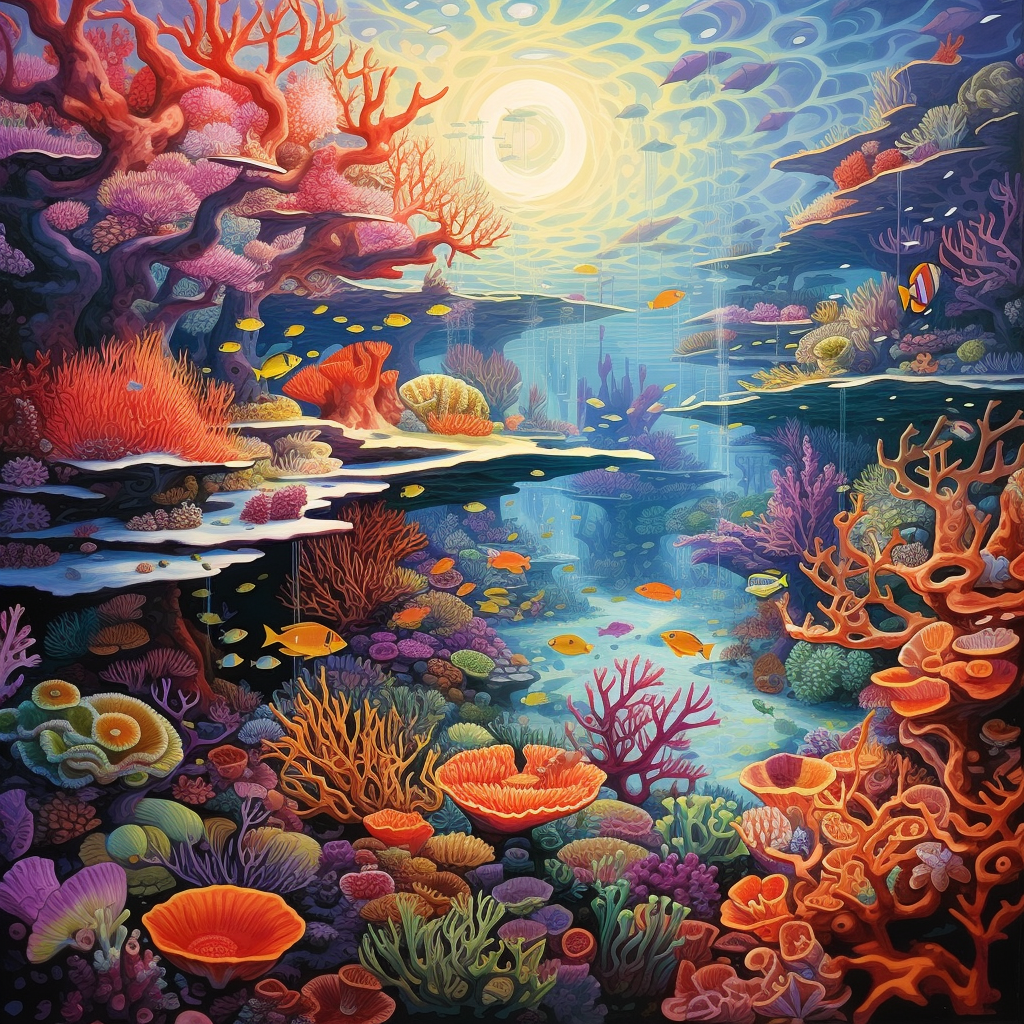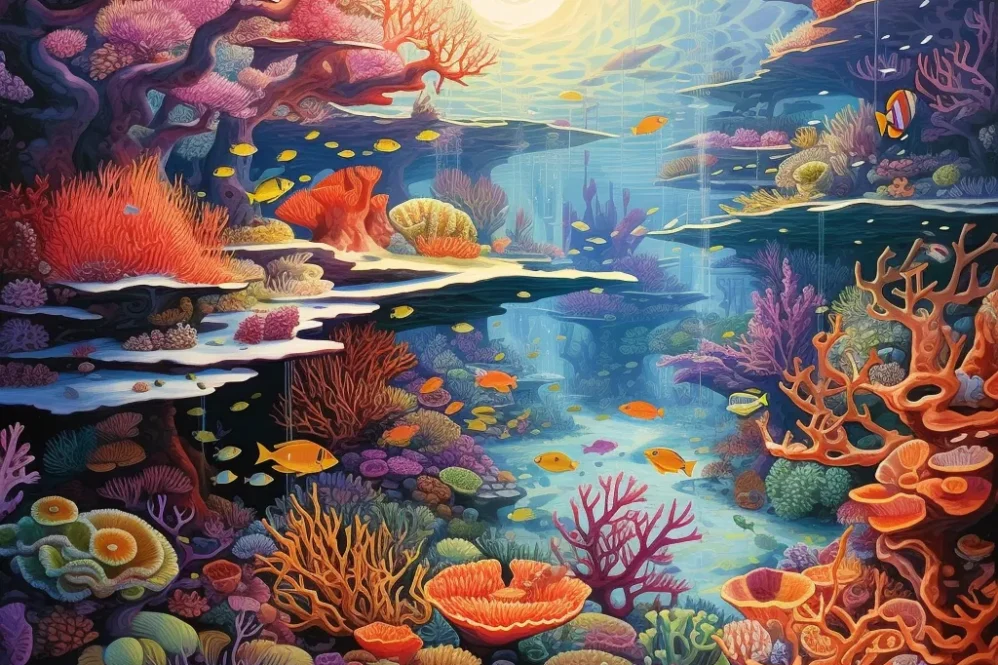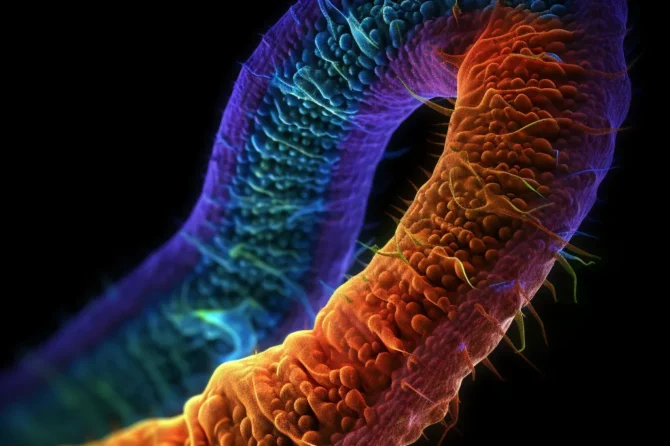Abstract:
A groundbreaking study led by marine biologists from Rice University and Oregon State University has unveiled a fascinating revelation – remnants of ancient RNA viruses embedded in the DNA of coral symbionts living within reef-building corals. Published in the prestigious open-access journal Communications Biology, this research has captured the attention of the scientific community and promises to revolutionize our understanding of the interactions between coral symbionts and viral infections.
Reef-building corals are vital components of marine ecosystems, forming intricate structures that support a diverse array of marine life. However, these delicate ecosystems have been under threat due to climate change and various anthropogenic impacts. Understanding the factors that influence coral symbionts’ health is of paramount importance in developing strategies for conservation and restoration efforts.
Traditionally, viral infections have been viewed as acute and transient events in the context of coral symbionts’ health. However, the recent findings from this study challenge this conventional understanding. By uncovering the presence of ancient RNA viruses integrated into the DNA of symbiotic organisms within corals, scientists have opened a new frontier in coral symbionts-virus interactions. This groundbreaking discovery highlights the complexity of the relationship between viruses and their coral symbiont hosts and indicates that viral integration into coral symbiont genomes may be more prevalent and influential than previously thought.
The process of viral integration into host DNA is a phenomenon known as endogenization, and it has long been recognized in the context of vertebrate evolution. However, this study marks the first time that evidence of viral endogenization has been observed in coral reefs and specifically in coral symbionts. The implications of this finding extend far beyond the realm of marine biology and have the potential to revolutionize our understanding of virus-host dynamics in diverse ecosystems, particularly in the context of coral symbionts.
Furthermore, the discovery of ancient viral remnants in coral symbiont DNA provides valuable insights into the historical interactions between corals and viruses. It offers a glimpse into the coevolutionary history of corals and viral pathogens within coral symbionts, shedding light on the mechanisms that have shaped their symbiotic relationships over millennia. Understanding these historical dynamics is essential in predicting how coral reefs, through their symbiotic associations with dinoflagellate algae, may respond to current and future challenges, including rising sea temperatures, ocean acidification, and increased pollution.
In addition to its scientific significance, this research has substantial ecological and economic implications for coral symbionts and coral reef ecosystems. Coral reefs, with their intricate network of symbiotic relationships, are not only vital habitats for marine biodiversity but also play a crucial role in supporting fisheries, tourism, and coastal protection. Viral infections can have a profound impact on the health and stability of coral symbionts, leading to coral bleaching, disease outbreaks, and even coral mortality. By unraveling the complex interactions between coral symbionts and viruses, scientists can better assess the ecological consequences of viral infections on coral reef ecosystems and the well-being of these essential marine organisms.
As climate change continues to pose a significant threat to coral reefs worldwide, this newfound understanding of viral integration in coral symbionts becomes even more critical. The interplay between viruses and coral symbionts may play a pivotal role in determining the resilience of coral reef ecosystems to environmental stressors. Armed with this knowledge about coral symbionts, conservationists and policymakers can develop targeted strategies to protect and restore coral reefs, preserving these invaluable marine ecosystems and the delicate balance they maintain for future generations.
Introduction:
Marine biologists from Rice University and Oregon State University have made a groundbreaking and remarkable discovery in the realm of coral biology. Through their research, they have identified fragments of ancient RNA viruses within the genomes of coral symbionts, revealing a fascinating and previously unknown aspect of the complex relationship between corals and viruses.
The discovery of these ancient viral remnants within coral symbionts has significant implications for our understanding of coevolution between corals and viruses. The remnants, dating back as far as 160 million years, provide valuable insights into the historical interactions between these two organisms and the intricate evolutionary dance that has shaped their symbiotic relationship over millions of years.
Viral integration into host genomes is a well-known phenomenon, primarily observed in retroviruses like HIV. However, the presence of fragments of non-retroviral RNA viruses embedded in coral symbionts challenges our existing knowledge in the field. This unexpected finding raises intriguing questions about the mechanisms behind viral integration into host DNA in non-retroviral viruses and the potential impacts of such integration on coral symbionts.
One of the key questions that arise from this discovery is how these ancient viral fragments have endured in the genomes of coral symbionts over such vast periods of time. Understanding the mechanisms that allow viral genetic material to persist within host DNA for millions of years may provide valuable insights into the coevolutionary dynamics between corals and viruses. It could also shed light on the mechanisms that govern the stability and adaptation of coral symbionts to changing environmental conditions.
Furthermore, the presence of these ancient viral fragments in coral symbionts raises questions about their potential functions and implications for the health and resilience of coral reefs. It is well-established that viruses can have profound effects on coral health, including causing diseases and contributing to coral bleaching events. The integration of viral genetic material into coral symbiont genomes may influence their response to viral infections, affecting their ability to withstand stressors such as rising sea temperatures and pollution.
This discovery also highlights the complexity and intricacy of the coral holobiont, which encompasses not only the coral host but also its associated microorganisms, including viruses. The holobiont is an interconnected system where the health and dynamics of one component can have cascading effects on the entire system. Understanding the role of viral fragments within the coral holobiont may provide crucial insights into the delicate balance that governs the functioning and resilience of coral reefs.
As the world faces unprecedented challenges, including climate change and the degradation of marine ecosystems, this discovery holds immense significance for coral reef conservation and restoration efforts. By unraveling the mysteries of viral integration within coral symbionts, scientists can develop targeted strategies to protect and preserve these fragile and invaluable marine ecosystems.
The Study on Coral Symbionts:
The research team, comprising marine biologists and geneticists, embarked on a comprehensive investigation to explore the prevalence and significance of endogenous viral elements (EVEs) in coral symbionts, focusing on dinoflagellates residing within corals. Dinoflagellates are single-celled algae that form a crucial mutualistic relationship with corals, providing them with essential nutrients through photosynthesis and contributing to the stunning and diverse colors of coral reefs.
The presence of EVEs within dinoflagellates is a remarkable discovery in itself, as these elements are remnants of viral genetic material that have become integrated into the host’s genome over time. While the phenomenon of viral integration is well-known in retroviruses, the presence of EVEs from non-retroviral RNA viruses challenges established notions in virology and molecular biology. This unexpected finding opens up exciting avenues of research to better understand the interactions between corals, dinoflagellates, and RNA viruses.
The study’s scope was extensive, involving the collection of samples from various coral reef sites across different geographical locations. This approach allowed the researchers to examine the diversity and prevalence of EVEs within dinoflagellates in a broader ecological context. By analyzing samples from diverse coral ecosystems, the researchers aimed to gain insights into the evolutionary history and coevolutionary dynamics between corals, dinoflagellates, and viruses.

To unravel the genetic makeup of dinoflagellates and identify the presence of EVEs, the team employed state-of-the-art genomic techniques. These advanced methodologies enabled the researchers to extract and analyze the DNA of dinoflagellates at a level of precision and depth previously unattainable. By examining the genomes of dinoflagellates, the researchers could identify and characterize the integrated viral fragments and gain a deeper understanding of their functions and potential impacts.
The implications of discovering EVEs from non-retroviral RNA viruses within dinoflagellates are profound. Firstly, this finding challenges the traditional view that endogenous viral elements are primarily associated with retroviruses. It suggests that the interactions between RNA viruses and their hosts, particularly dinoflagellates in this case, might be more complex and diverse than previously thought.
Moreover, the presence of EVEs in dinoflagellates raises intriguing questions about the coevolutionary history between these single-celled algae and RNA viruses. How did these viral fragments become integrated into the dinoflagellate genome, and what role have they played in shaping the genetic diversity and adaptive traits of dinoflagellates over evolutionary time scales?
The study also highlights the interconnectedness of coral reefs as ecosystems. Understanding the dynamics between corals, dinoflagellates, and viruses is crucial for comprehending the resilience of coral reefs in the face of environmental stressors, such as climate change, pollution, and disease outbreaks. The presence of EVEs in dinoflagellates may provide important insights into how these organisms have evolved to withstand various challenges and how viral infections may influence their response to stress.
As marine ecosystems face unprecedented threats due to human activities and global environmental changes, understanding the intricacies of coral symbiosis and the interactions with viral elements is of utmost importance. Coral reefs are not only a source of wonder and beauty but also vital hubs of marine biodiversity and ecological balance. Protecting and preserving these delicate ecosystems requires a comprehensive understanding of their inner workings and the factors that contribute to their stability and resilience.
Surprising Discoveries:
The groundbreaking research conducted by the team of marine biologists from Rice University and Oregon State University has not only brought to light the presence of endogenous viral elements (EVEs) in coral symbionts but has also revealed that this integration of RNA virus fragments is more widespread than previously believed. This finding challenges the conventional understanding of viral interactions with host genomes and opens up exciting new avenues of exploration in the field of virology and marine ecology.
Despite the widespread presence of EVEs in the genomes of dinoflagellates, the exact purpose and functional significance of this integration remain uncertain. However, scientists are increasingly intrigued by the potential benefits that such integration could confer to the host organisms. One compelling hypothesis is that these ancient viral elements may play a role in the antiviral defense mechanisms within dinoflagellates.
Over millions of years of coevolution, dinoflagellates and viruses may have engaged in a dynamic arms race, wherein the viruses seek to infect the dinoflagellates, and the dinoflagellates evolve mechanisms to defend against these viral invasions. The integration of viral fragments into the dinoflagellate genome could represent a strategy developed by the host to recognize and combat specific viral threats. These remnants of past viral infections may serve as a memory of previous encounters, enabling dinoflagellates to mount a more effective immune response when faced with contemporary RNA viral infections.
The preservation of EVEs over such extended evolutionary timescales suggests that these elements have conferred some selective advantage to the dinoflagellates that carry them. The ability to retain and propagate these viral fragments across generations implies that they are not merely “genetic fossils” but have ongoing functional relevance within the biology of the host organisms.
Understanding the potential role of EVEs in antiviral defense mechanisms can have significant implications for coral reef health and resilience. Coral reefs are facing unprecedented challenges due to climate change, ocean acidification, pollution, and disease outbreaks. Viral infections have been identified as one of the contributing factors to coral reef decline and bleaching events. By deciphering the interplay between RNA viruses and EVEs within dinoflagellates, scientists may gain insights into the mechanisms that influence the susceptibility of corals to viral infections.
Moreover, the study raises intriguing questions about the broader impact of these ancient viral elements on the contemporary health of coral reefs. Do the EVEs influence the overall fitness and reproductive success of dinoflagellates and, consequently, the well-being of the entire coral ecosystem? Understanding the dynamics between EVEs and contemporary viral infections may provide valuable insights into the resilience of coral reefs in the face of changing environmental conditions.
In addition to its significance for coral reef ecology, the discovery of widespread EVE integration in dinoflagellates holds implications for virology and the understanding of viral evolution. Non-retroviral RNA viruses represent a vast and diverse group of viruses that infect a wide range of organisms, including plants, animals, and humans. The study of EVEs in dinoflagellates offers a unique opportunity to explore the interplay between these ancient viral elements and contemporary viral infections, shedding light on fundamental aspects of viral-host interactions.
As the research community delves deeper into the intricacies of viral integration in coral symbionts, it is clear that this discovery marks a significant milestone in our understanding of the complexity of life on coral reefs. The relationship between corals and dinoflagellates is a cornerstone of reef-building and is central to the vibrant biodiversity and ecological balance of these underwater wonderlands. Unraveling the mysteries of viral integration within this mutualistic association has the potential to enrich our knowledge of marine ecosystems and contribute to the conservation and protection of coral reefs.
Implications for Reef Health:
In the face of mounting threats posed by climate change and its impact on marine environments, understanding the intricate dynamics between corals, their symbionts, and viral infections is of paramount importance. Coral reefs, often referred to as the “rainforests of the sea,” harbor an astounding diversity of marine life and provide essential ecosystem services, such as coastal protection, fisheries support, and tourism revenue. However, these invaluable ecosystems are facing unprecedented challenges, with climate change being one of the most significant drivers of their decline.
As global ocean temperatures continue to rise, coral reefs are confronted with a multitude of stressors, collectively known as coral reef bleaching events. These events result from the disruption of the symbiotic relationship between corals and their dinoflagellate symbionts, leading to the expulsion of these colorful algae and causing the corals to turn pale or white. Prolonged and severe bleaching can lead to coral mortality, devastating entire reef ecosystems and the myriad of species that rely on them for survival.
In this context, the recent discovery of endogenous viral elements (EVEs) within coral symbionts presents an exciting opportunity to delve deeper into the interplay between viruses and their hosts and its potential implications for coral reef health. The integration of RNA virus fragments into the genomes of dinoflagellates raises intriguing questions about the functional significance of this viral incorporation. While the exact roles of EVEs in dinoflagellate biology are yet to be fully elucidated, scientists are increasingly drawn to the possibility that these ancient viral elements may have played a crucial role in the coevolutionary history between dinoflagellates and viruses.
One of the most tantalizing hypotheses is that EVEs could serve as a reservoir of genetic information that may contribute to the antiviral defense mechanisms of dinoflagellates. Over millions of years, dinoflagellates and viruses may have engaged in a complex arms race, with dinoflagellates evolving defense mechanisms to fend off viral infections, and viruses adapting to overcome these defenses. The integration of viral fragments into the dinoflagellate genome could have provided the host organisms with a genetic memory of past viral encounters, enabling them to recognize and combat contemporary RNA viral infections more effectively.
The implications of this discovery become even more pronounced when considering the current threats faced by coral reefs. As ocean temperatures rise and marine environments experience increased stress, corals become more vulnerable to disease outbreaks and viral infections. The presence of EVEs in dinoflagellates may either enhance or diminish the host’s ability to mount an effective immune response against these contemporary viral threats.
If EVEs indeed play a role in enhancing antiviral defenses, they could act as a natural adaptation mechanism for dinoflagellates to cope with the rising prevalence of viral infections under changing environmental conditions. On the other hand, if the integration of viral elements has a detrimental impact on the dinoflagellates’ immune responses, it could exacerbate the susceptibility of corals to viral infections, further compromising the health and resilience of already stressed reef ecosystems.
Given the urgency of protecting coral reefs and the diverse marine life they support, it becomes clear that studying viral interactions in the context of environmental stressors is critical. By unraveling the mechanisms behind the integration of EVEs and their potential role in antiviral defense, scientists may gain essential insights into the adaptability and survival mechanisms of coral symbionts in the face of climate change-induced challenges.
The findings from this research underscore the need for comprehensive monitoring and conservation efforts to safeguard coral reef ecosystems. As ocean warming and other environmental stressors continue to escalate, understanding the complexities of viral interactions becomes imperative for devising effective strategies to mitigate the impacts on coral reefs.
Conclusion:
The revelation of ancient RNA virus remnants integrated within the DNA of coral symbionts marks a significant milestone in the field of virology and marine biology. This groundbreaking research not only expands our knowledge of viral interactions but also provides a valuable foundation for understanding the intricate relationships between viruses and their hosts. By identifying and analyzing these endogenous viral elements (EVEs) within dinoflagellates, the single-celled algae that reside within corals and contribute to the vibrant colors of coral reefs, scientists have uncovered a hidden dimension of viral coevolution that challenges previous assumptions about viral integration.
Traditionally, viral integration into host genomes has been predominantly associated with retroviruses, such as HIV, which have the unique ability to convert their RNA genomes into DNA and insert them into the host’s genome. However, the discovery of non-retroviral RNA virus fragments within the dinoflagellate genomes represents a departure from this conventional understanding. This unexpected finding raises intriguing questions about the mechanisms behind viral integration and suggests that there may be more diversity in the ways viruses interact with and influence their host organisms than previously known.
The presence of EVEs in coral symbionts offers an exciting opportunity for further exploration into the impact of viruses on coral reef health. These ancient viral remnants, dating back as far as 160 million years, suggest that dinoflagellates have a long history of interacting with viruses, possibly engaging in a complex coevolutionary dance that shaped their genetic makeup over evolutionary time scales. Understanding the role of these viral elements in the biology of dinoflagellates could shed light on the interactions between viruses and their hosts, potentially revealing novel defense mechanisms or other functions that have shaped the symbiotic relationship between corals and their algal partners.
Moreover, this discovery has broader implications for virology research and our understanding of viral dynamics in both marine and terrestrial ecosystems. It challenges the traditional view of viruses as solely pathogenic agents and opens up new avenues of investigation into the coexistence and coevolution of viruses with their hosts. By studying the mechanisms by which EVEs have been preserved within dinoflagellate genomes over millions of years, scientists can gain insights into the genetic strategies that organisms employ to cope with viral infections and the evolutionary arms race between viruses and their hosts.
Beyond the realm of marine biology, the findings from this study may have relevance for understanding viral dynamics in terrestrial ecosystems as well. Viruses play a crucial role in shaping the genetic diversity and evolution of organisms across all domains of life. Investigating how viruses interact with and influence their hosts’ genomes can provide valuable insights into the broader field of virology and its implications for ecological and evolutionary processes.
As coral reefs face unprecedented threats from climate change, understanding the impact of viruses on these delicate ecosystems becomes even more critical. Rising ocean temperatures, ocean acidification, and other environmental stressors have put coral reefs under immense pressure, leading to widespread coral bleaching events and decline in reef health. The presence of EVEs within dinoflagellates raises intriguing questions about how viral interactions may be influenced by environmental stress and how these interactions may impact the ability of corals to withstand and recover from disturbances.
By elucidating the mechanisms of viral integration and exploring potential antiviral strategies within coral symbionts, scientists can pave the way for targeted interventions to protect and restore coral reefs. Developing a deeper understanding of how viruses interact with their hosts at a genetic level may lead to innovative approaches for boosting the resilience of corals and their symbiotic algae, providing hope for the future of these vital marine ecosystems.
In conclusion, the discovery of ancient RNA virus remnants within the DNA of coral symbionts has far-reaching implications for our understanding of viral interactions and their impact on coral reef health. This groundbreaking research challenges previous assumptions, opens up new avenues of investigation, and contributes to our broader understanding of the complex dynamics between viruses and the organisms they infect.
By exploring the mechanisms of viral integration and studying the coevolutionary history between viruses and their hosts, scientists can gain insights into the genetic strategies that have shaped the symbiotic relationships between corals and their algal partners. With climate change threatening coral reefs worldwide, the knowledge gained from this study may hold the key to developing targeted interventions to protect and conserve these critical ecosystems for future generations. Ultimately, this research expands our understanding of the delicate balance between viruses and their hosts, with implications not only for marine ecosystems but also for terrestrial life.
If you need more information on this article click on the following link. This link will provide more extensive information and elaborate on the topic.
Genomic.News is your ultimate source for curated news, articles, and updates on the fascinating world of genomics. Our platform brings together the latest scientific breakthroughs, research advancements, and industry developments in one centralized hub. Stay informed about the cutting-edge discoveries, transformative technologies, and ethical considerations driving the field of genomics. Explore the intersection of genetics and healthcare, agriculture, biotechnology, and beyond.





